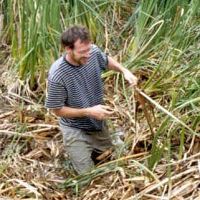Goulden et al., 2016
Widespread tree mortality with the ongoing California drought: the roll of water balance and temperature
Goulden, M.; Bales, R.C. (2016)
Fall Meeting, American Geophysical Union, December 2016. Abstract GC32C-05.
-
Sierra, INVESTIGATOR
-
Sierra, INVESTIGATOR
Abstract
The southern Sierra Nevada experienced extreme drought, heat and forest dieback from 2012-16, with ~50% below average P, ~3oC above average T, and tens of millions of trees dying. The drought and dieback were widespread at the Southern Sierra Critical Zone Observatory (SSCZO). The SSCZO provides a rich suite of meteorological, ecological and hydrologic datasets, including many that began around 2010 and include two wet years followed by the intensifying drought. The SSCZO observations span an altitude gradient; this gradient includes a xeric pine and oak forest at ~1200 m, which is near the lower ecotone of closed canopy forest, and a mesic pine and fir forest at ~2100 m.
Findings include: 1) Tree death was greater at 1200-m, following the altitudinal pattern seen across central CA, with dieback focused in the lower parts of species and ecosystem type ranges. 2) Mortality was associated with a year over year depletion of subsurface moisture. The cumulative overdraft (P-ET) at 1200 m exceeded 100 cm; the cumulative P-ET at 2100 m was near zero. 3) Much of the accelerated moisture depletion at 1200-m was associated with warmer temperatures and a greater evaporative demand. The 1200 and 2100 m sites experienced similar annual precipitation, and the rate of ET at comparable temperatures was also similar. The lower site was ~5oC warmer on average, which led to ~40% greater ET, and a more rapid depletion of belowground moisture. 4) A similar pattern was observed in Landsat and MODIS imagery. Mortality was high below 1600 m and low above 2000m. Mortality decreased rapidly with elevation and cooler temperatures from 1600 to 2000 m. Mortality in the 1600 to 2000 m zone was well correlated with Land Surface Temperature, with greater mortality on warm, southern slopes and less mortality on cool, northern slopes. In combination these findings illustrate the interacting effect of drought and temperature in controlling the patterns of tree death accross the Southern Sierra Nevada.
Citation
Goulden, M.; Bales, R.C. (2016): Widespread tree mortality with the ongoing California drought: the roll of water balance and temperature . Fall Meeting, American Geophysical Union, December 2016. Abstract GC32C-05..
Explore Further


